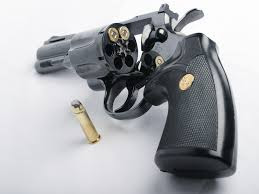How Revolvers Work
In 1830, when he was only 16, Samuel Colt left home and took a job on a merchant ship bound for India. In his spare time, he toyed with designs for a new sort of gun - one that could be fired repeatedly without reloading. While a number of repeating weapons had already been developed, none of them had caught on with the public, mostly because they were too complicated and cumbersome.
Inspired by a capstan mechanism on the ship, Colt developed a simple revolving ammunition cylinder. Initially, people weren't particularly impressed with the new weapon; but by the 1850s, Colt's company was enjoying phenomenal success. In 1856, he had to churn out 150 guns a day just to keep up with the growing demand!
Gun Basics and History
To understand how a revolver works, it helps to know something about guns in general. Almost every gun is based on the same simple concept: You apply explosive pressure behind a projectile to launch it down a barrel. The earliest and simplest application of this idea is the cannon.
A cannon is just a metal tube with a closed end and an open end. The closed end has a small fuse hole. To load the cannon, you pour in gunpowder (a mixture of charcoal, sulfur and potassium nitrate), and then drop in a cannonball. The gunpowder and cannonball sit in the breech, the rear part of the bore (the open space in the cannon). To prepare for a shot, you run a fuse (a length of flammable material) through the hole so it reaches down to the gunpowder. To fire the cannon, you light the fuse. The flame travels along the fuse and finally reaches the gunpowder.
The Revolver
The first revolvers used gunpowder, balls and caps like the earlier percussion-cap pistols. The shooter would load each of the six chambers in the cylinder with gunpowder and a projectile, and place separate percussion caps on corresponding nipples. While the loading procedure was tedious, a shooter could have six rounds fully prepared ahead of time.
In the 1870s, these models were replaced by revolvers that used bullet cartridges instead of gunpowder and caps. Cartridges are a combination of a projectile (the bullet), a propellant (gunpowder, for example) and a primer (the explosive cap), all contained in one metal package.



No comments:
Post a Comment